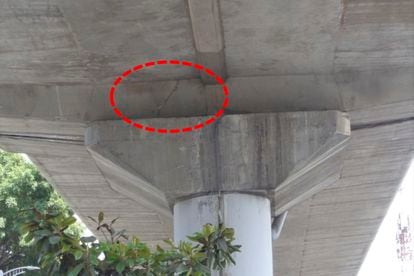Cracks in columns, beams (beams) and heads. Deformations in supporting elements. Questionable construction practices identified in some welds. These are the results of an inspection by the College of Civil Engineers of Mexico (CICM) of the elevated section of Line 12 of the Mexico City metro, presented this Thursday at the request of the Government of Claudia Sheinbaum. The report, which excludes the area where the collapse of May 3 occurred, shows that 32% of the viaduct has structural deficiencies and vulnerabilities in the civil works. The reference body in Civil Engineering has clarified that they are not sections of maximum degree of risk,but he has warned that immediate reviews must be made and priority attention must be given to make the construction safer after the collapse that left 26 deaths and dozens of injuries. The CICM recommended that the line's service remain suspended.
More information
Ebrard alleges that the construction of Line 12 was endorsed by a committee of experts
Opinion |
'The lowest hour of Ebrard, an expert in resurrections', by Salvador Camarena
López Obrador announces that the expert opinion on the tragedy of Line 12 will be presented this week
The College also found leaks in some concrete slabs and that the spacing between the beams was insufficient. Also, some diaphragms, which are metal elements that help distribute loads to the beams and columns, are misplaced or not at all. There were also deficiencies in the stiffeners, which are pieces of steel that give stability to the beams and which presented inconsistencies: some were shorter, others longer. The specialists also found welds made right in the middle of the clearing (the space between two columns), which is not prohibited in the building laws, but they did qualify as a “questionable practice”. Seven of the 12 sections with the highest degree of structural risk are two stations to the east of the Olivos station, where the accident occurred.
Deficiencies in the structure of the elevated section of Line 12 found by the Colegio de Ingenieros Civiles de México.
All these deficiencies were appreciated with the naked eye, in a series of field inspections carried out by 37 brigades of expert engineers between 5 and 8 May last.
The committee that analyzed these problems has 32 specialists in structures, geotechnics, responsible for works and structural safety who worked on a voluntary basis.
The CICM recommended that the cracks in the columns, the cracks that caused leaks in the concrete slabs and the heads damaged by the work of the seismic buffers be repaired as soon as possible.
The report also suggests that the reinforcement that was made near the Nopalera station, part of the repairs after the 2017 earthquake, be reviewed.
In the more than 11 kilometers that run through the elevated section, the schools found that the remaining 68% have problems that can be solved with routine maintenance. A three-kilometer stretch, which does not combine steel and concrete in the bridges, has no significant deficiencies. The studies in the so-called ground zero, between the Tezonco and Olivos stations, will be presented in the following analysis phases, still without a date for publication, and the experts clarified that exhaustive reviews must be made to confirm the preliminary findings.
The College also made an inspection on the part of Line 12 that runs in underground tunnels.
The main problem is leaks, leaks and water runoff, but it does not present any structural damage and, according to the union, it can "be reopened" in the short term. "
There will also be studies on Lines 4, 9 and B, where possible failures in civil works have been identified.
Fissure found during the inspection of the College of Civil Engineers of Mexico (CICM) to the elevated section of Line 12.CICM
The CICM inspection came a day after the first preliminary ruling on the tragedy, drawn up by the Norwegian company Det Norske Veritas. The expert report identified that the trigger for the collapse was a structural failure caused by deficiencies of origin in the construction, especially problems with the bolts that joined the concrete and steel, and poorly made and supervised welds. The results focused attention on the management of Marcelo Ebrard in the capital, from 2006 to 2012, when the line was built and inaugurated. Grupo Carso, owned by magnate Carlos Slim and who built the section that fell, lost 3,141 million pesos (156 million dollars) on the stock market in the hours that followed the presentation.
Ebrard, current Secretary of Foreign Relations, alleged in a statement that the construction was endorsed by a recognized committee of national and international experts.
Miguel Ángel Mancera, his successor, argued that he did "everything he had to do, everything the experts told me."
According to his schedule, Sheinbaum was going to attend the presentation of the results of the College of Civil Engineers, but did not appear.
The director of the metro, Florencia Serranía, has not been summoned to any of the reports and has not had public appearances in the six weeks that followed the tragedy.
Subscribe here
to the
newsletter
of EL PAÍS México and receive all the informative keys of the current situation of this country

